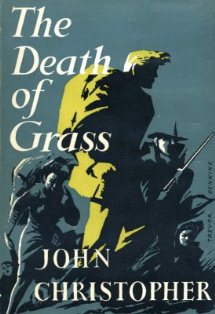
First published back in 1956, British author John Christopher’s (the pseudonym adopted by Christopher Samuel Youd) third published novel ‘The Death Of Grass’ was the first of a number of tales written by the author that delved into a post-apocalyptic premise. The novel has since become a Penguin Modern Classic, receiving worldwide success and being dubbed a masterpiece in post-apocalyptic fiction. The book was also a runner-up for the International Fantasy Award in 1957. The novel was renamed ‘No Blade Of Grass’ for the US publication.
DLS Synopsis:
A highly contagious rice virus dubbed ‘The Chung-Li Virus’ has brought China to its knees. Massive famine resulting from the complete destruction of the Far East’s rice fields has left an estimated 200 million Chinese citizens either dead or dying. The virus continues to spread west, mutating as it goes, until the fifth strain of the virus hits the UK.
A counter-virus is quickly established, in a vain hope of killing off the Chung-Li virus. The British government insists that it has everything under control. However, the British Prime Minister quickly steps down and Cabinet Member Raymond Welling takes his place, with one of his first moves being to orchestrate a plan to bomb all of the major UK cities in order to limit the amount of strain put on the nation’s swiftly depleting food supplies.
Learning of the government’s secretive plans, middle-aged architect John Custance , together with his civil servant friend Roger Buckley quickly set off with their families to John’s brother’s potato farm in the isolated Westmorland valley at Blind Gill. There the natural form of the land, together with the winding River Lepe, forms a perfect hideaway that could be easily fortified and protected.
The two families head North for the protection of Custance’s brother’s farm; stopping at a London gunsmiths on the way where they pick up the gun dealer Pirrie and his wife (together with a healthy collection of guns ) who join the band on their journey North. But the population of Britain soon learn of the government’s desperate plans for limiting the amount of mouths to feed. Panic and unrest quickly follows, leaving the now hungry land an increasingly hostile and dangerous place to be…
DLS Review:
For a start it must be stated that this is an absolute classic...and rightly so. ‘The Death Of Grass’ is nothing short of a powerfully emotive tale of absolute desperation in the face of an all too real post-apocalyptic premise. Christopher sets off the tale, laying down the facts of the virus in a very harsh and bullet pointed fashion. The reality of the situation is established within a few pages, and from here on life takes a swift and very abrupt turn for the worse.
Within the space of a couple of short chapters, Britain is on the verge of absolute collapse. The catastrophe of the situation is all of a sudden on the doorsteps of our principal characters. From here Christopher builds up the tension, with the desperation of the Custance family and their plight from London cranking up the pace and the sudden realness of the threat as a whole.
As their journey North progresses, so the reader is subjected to a gradual change in all of the characters, as one by one they begin to harden and adapt to these very new circumstances. With John Custance leading the band, his own personal loss of any sympathetic qualities is the most pronounced; with his decisions literally meaning the death of others in order for the groups journey North to progress.
Rape, murder, robbery and theft quickly become the norm across the landscape of Britain. Governmental roadblocks are erected within hours, but their guards are easily overpowered. It’s is now a savage dog-eat-dog world where the only way to survive is to find somewhere safe and isolated to hide and protect it with your very life.
The chaos that quickly erupts around Custance’s band seems to snowball as the novel progresses. The reader is never sure what is around the next corner on this terrifying trek to their hopeful salvation. Along their way the scenes of violence that the band are exposed to quickly harden them up, until their own moral high ground is long forgotten.
Christopher knows how to provoke a deep-rooted reaction from the reader. He knows what will hit a chord and what will unsettle the mind. The changes in the general morality and the good honest human qualities that we recognise having had them instilled within us from our modern day society are gradually eradicated throughout the journey. No longer can the reader feel morally attached to the group. Suddenly, the novel takes on a very brutally harsh reality – it’s now kill or be killed.
‘The Death Of Grass’ is no doubt a monumentally important novel in the history of post-apocalyptic fiction. It’s sheer unapologetic brutality and hard-hitting concept has since spawned many different routes for the subgenre to explore. The novel is powerful, evocative, gripping and disturbing. It shows humanity at its most desperate. It seems frighteningly real and hauntingly possible. The novel is one that remains even to this day as one of the most emotionally provocative pieces of end of the world fiction that has been written.
The novel was later adapted into the film ‘No Blade Of Grass’ (1970) which was produced and directed by Cornel Wilde.
The novel runs for a total of 231 pages.
© DLS Reviews






